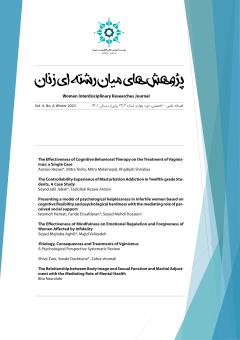The Experience of Controllability of Masturbation Addiction in a Twelfth Grade Student, a Case Study
Subject Areas :Seyed Jalil Jebeli 1 , fazlollah Rezai Ardani 2 *
1 - Master in family counseling, Department of Counseling, Faculty of Psychology and Educational Sciences, University of Tehran.
2 - Assistant Professor, Department of Educational Sciences, Shahid Paknejad Campus, Farhangian University, Yazd, Iran. (Corresponding Author)
Keywords: Adolescence, Masturbation, Academic failure, Lived experience,
Abstract :
The present study aimed to know the factors, complications, and controllability of masturbation addiction in twelfth-grade students. the present research is single-case experimental research. The participants of this study are all male students. According to their own words, are addicted to masturbation and have shared it with their teacher. One person who was in the severe category was selected intentionally by considering the entry and exit criteria of the study. Finally, the person's lived experience in the stages of baseline, treatment, post-treatment, and follow-up, respectively through a semi-structured interview. It was determined in four axes that 1. The frequency of masturbation was five times a week since three months ago, and the most important reasons; Loneliness, lack of physical activity, and watching movies were mentioned 2. The consequences of starting this behavior include a drop in academic grades, avoidance of responsibility at home and isolation at school, and a drop in cheerfulness. In the last 2 axes, after two months of implementation of therapeutic techniques, the frequency of this procedure decreased to one-fifth compared to the baseline. The drop in his grades was temporary, He became more social in school and more responsible at home, and his cheerfulness increased. Controlling this problem is not only possible but also promotes health growth in social, academic, personal, and family fields.
1- احمدی، و.، احمدی، س.، شیخ حسین، آ.، و ملاجعفر، ه. (1391). شیوع شناسی خودارضایی در بین دانشجویان ساکن خوابگاههای دانشگاه شهید چمران اهواز، کنگره انجمن روانشناسی ایران.
2- اصغری نکاح، س. م.، و مهاجربعد، ز. (1400). کاوشی کیفی در عوامل سوقدهنده دختران نوجوان به خودارضایی از منظر الگوی تربیت جنسی خانواده محور مبتنی بر رشد، خانواده و سلامت جنسی، 1(2)، 7-16.
3- آذربادکان، ف.، آقامحمدیان شعرباف، ح.، و عبدخدائی، م. س. (1399). تدوین پروتکل کنترل خودارضایی؛ با تأکید بر رویکرد اسلامی و امکانسنجی آن: «تک آزمودنی». روانشناسی دین، 13(4)، 73- 92.
4- بورگ، و.، گال، ج.، و گال، م. د. (1393). روش¬های تحقیق کمی و کیفی در علوم تربیتی و روانشناسی (جلد 1). ترجمه خیر، م.، پاک¬سرشت، م. ج.، شهنی ییلاق، م.، عریضی، ح. ابوالقاسمی، م.، خسروی، ز. و همکاران. انتشارات سمت. تهران.
5- پارسا، م. (1393). روانشناسی رشد کودک و نوجوان. انتشارات بعثت. تهران.
6- پناهی، ع. ا. (1386). مهمترین آسیب جنسی دوران نوجوانی و راهکارهای پیشگیری و درمان. معرفت، 26، 29-54.
7- چوبفروش، آ.، سعیدمنش، م.، و گلیمی، ا. (1398). اثربخشی درمان مبتنیبر شفقت خود بر مؤلفههای حرمت خود نوجوانان دارای رفتار خودارضایی وسواسی. مجله مطالعات ناتوانی، 9، ۲۶-۲۶.
8- حسنزاده، ج.، سعیدیان اصل، م.، و آقامحمدیان، ح. (1389). شیوع شناسی خودارضایی در بین دانشجویان. مجموعه مقالات روانشناسی معاصر، 5، 271-272.
9- طاهری، ز.، رضایی جمالویی، ح.، و زمانی، س. (1398). تأثیر آموزش تحمل پریشانی بر توانایی تنظیم هیجانی و بهبود نارسایی هیجانی مبتلایان به اختلال نیمه بالینی خودارضایی. سلامت روان کودک (روان کودک)، 6(1)، 54-69.
10- قائمی، ع. (1390). خانواده و مسائل جنسی. انجمن اولیا و مربیان. تهران.
11- کجباف، م. ب. (1394). روانشناسی رفتار جنسی. انتشارات روان. تهران.
12- موحدی، م. م. (1390). دانستنیهای زناشویی. انتشارات علم. تهران.
13- نریمیسایی، ف.، صفرزاده، س.، و مرعشیان، ف. (1400). مقایسه اثربخشی آموزش ایمنسازی در برابر استرس و آموزش خودشفقتورزی بر میزان گرایش به خودارضایی و هرزهنگاری اینترنتی در دانشآموزان پسر مقطع متوسطه دوم. رویش روانشناسی، ۱۰(۷)، ۱۷۵-۱۸۸
14- Anderson, C. M., & Kim, C. (2003). Evaluating Treatment Efficacy with Single‐Case Designs. Handbook of research methods in clinical psychology, 72-91.
15- Chowdhury, M. R. H. K., Chowdhury, M. R. K., Nipa, N. S., Kabir, R., Moni, M. A., & Kordowicz, M. (2019). Masturbation experience: A case study of undergraduate students in Bangladesh, Journal of Population and Social Studies, 27(4), 359-372.
16- Das, A. (2007). Masturbation in the United States. Journal of Sex & Marital Therapy, 33(4), 301-317.
17- Ebed Elkreem, H. E., Faheim, S. S., & Eltelt, R. H. (2017). Effect of Educational Program about Masturbation on Blind Adolescent Students’ Knowledge and Attitude. Alexandria Scientific Nursing Journal, 19(2), 87-102.
18- Janghorbani, M., Lam, T. H., & Force, Y. S. S. T. (2003). Sexual media use by young adults in Hong Kong: Prevalence and associated factors. Archives of sexual behavior, 32, 545-553.
19- Jiao, T., Chen, J., & Niu, Y. (2022). Masturbation is associated with psychopathological and reproduction health conditions: an online survey among campus male students. Sexual and Relationship Therapy, 37(2), 272-286.
20- Sadock, B. J. (2015). Kaplan & Sadock's synopsis of psychiatry: behavioral sciences/clinical psychiatry (Vol. 2015): Wolters Kluwer Philadelphia, PA.
21- Shekarey, A., Rostami, M. S., Mazdai, K., & Mohammadi, A. (2011). Masturbation: prevention& treatment. Procedia-Social and Behavioral Sciences, 30, 1641-1646.
22- Wang, R.-J., Huang, Y., & Lin, Y.-C. (2007). A study of masturbatory knowledge and attitudes and related factors among Taiwan adolescents. Journal of Nursing Research, 15(3), 233-242.
23- Westheimer, R. K., Lopater, S., Westheimer, L., & Lopater. (2002). Human sexuality: A psychosocial perspective (Vol. 88): Lippincott Williams & Wilkins.

